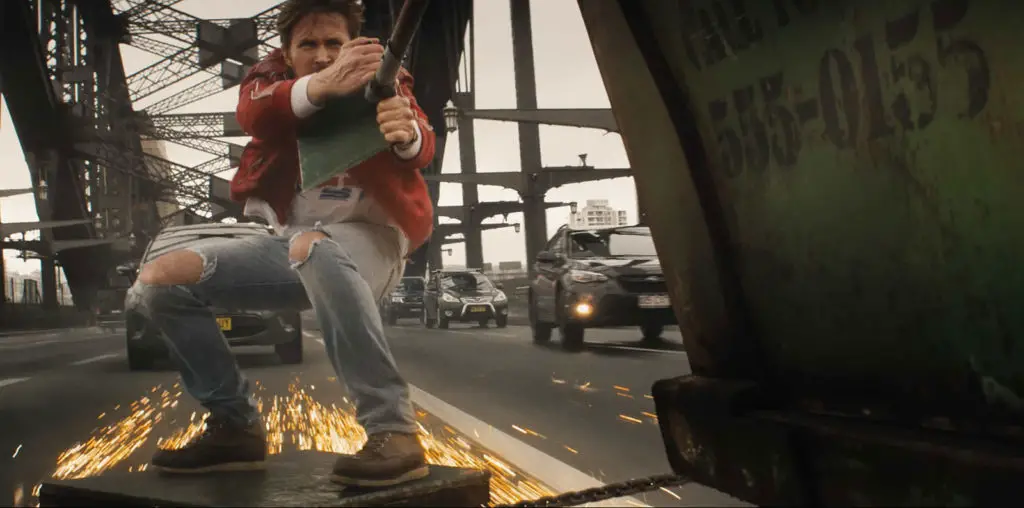
The 33-minute sci-fi short “Radius,” as well as the complete two-disc DVD set that heralds its official release, showcases what’s possible in today’s digital age if you’re good at wheeling and dealing. While its digital effects often match what you find in most video games, you have to remember that it cost somewhere around $60,000 to make, and every last penny of that money was left on the screen. In fact, I’d say “Radius” looks like a film that cost at least three or four times that amount. And don’t forget that video game graphics are pretty damn good these days.
The film tells the story of a reconnaissance ship that comes under fire during a futuristic war between humans and an enigmatic alien race called Gemini. When the ship crashes on a desolate planet, the crew learns that a CraterMaker, a nuclear warhead-like device, is on board, and that their captain is arming it. Pilot Mariella Dain takes care of that problem with one shot to the head, but she finishes arming it anyway, to the dismay of her fellow soldiers. Then she tells them to run like hell and off they go, trying to get beyond the blast radius.
As the crew makes their way across the barren desert that stretches for miles around them, the Gemini send in one of their warriors, who can split in two (hence the name of the species). One warrior stalks the crew while the other heads for the downed ship, hoping to stop the device before it goes off. That’s when we learn that the planet is actually a key Gemini power center, and that the CraterMaker will wipe it out, thus ending the war. So, of course, Dain turns around and goes back to the ship in an attempt to stop one Gemini warrior’s mission. The only problem is that these guys are nearly impossible to kill.
Like I said at the beginning, “Radius” shows what’s possible if you have enough moxie to make your dream a reality. With just a mid-five-figure budget, director Helmut Kobler, writer Jon Clarke and producer Andrew Trapani managed to cast a recognizable actor (Matt McCoy, who you might have seen in “L.A. Confidential” as well as in many guest roles on a bunch of TV shows) and a fine cast of unknowns and then round up a team that included effects people with experience on big budget Hollywood films. They even succeeded in convincing their cast and crew to film on location in 120-degree weather in southern California’s Death Valley, despite the fact that they were getting paid next to nothing for their efforts.
Its effects may be video game-like, but “Radius” makes up for that with a lot of excellent camera work, including a riveting in-cockpit sequence early on as the ship goes down, and great performances from the entire cast, which shows how well Kobler and his friends sold the project. Matt McCoy turns in the solid acting job you’d expect from a veteran, Catalina Larranaga proves her worth as Dain, an action heroine in the Sigourney Weaver mold, Michael Yavnieli offers up a character who’s reminiscent of Paul Reiser’s Burke in “Aliens,” and Paul Logan portrays plenty of bad a*s attitude as the twin Gemini warriors.
My only gripe about the film comes from the fact that I don’t completely understand Dain’s motivations, even after watching it twice. I won’t give away the secret revealed about her character at the end, but even with that knowledge in mind, I don’t quite understand why she seems so upset about the ship going down, nor why she offs the captain but then finishes arming the bomb. To keep up her image as someone she’s not? I’m not entirely sure.
Kobler decided to go all out with this DVD release, however, and put together what he calls “Guerilla film school in a box.” Disc one features two commentaries, one by the actors and one by the creative principals, as well as loads of on-set footage that you can watch by activating the picture-in-picture option and pressing “Enter” every time the box appears on the screen, but disc two is where this set really shines.
Kobler put together 26 tutorials, totaling over two hours of running time, that take you through every aspect of production, from the initial ideas for the film to casting to the trials and tribulations of shooting in miserable weather to post-production. The series really showcases the ingenuity of the entire crew as they solved problems (Need a hand grenade prop? Make one with a Red Bull can.), dealt with on-set tensions and pulled out all the stops to simply get the film done. Many people forget that filmmaking is all about creating illusions, and Kobler shows that you don’t need a soundstage to shoot close-ups of your female lead activating a CraterMaker if you can grab room next to someone’s kitchen and set up some red-gel lights that will mimic the doomed ship’s interior.
What’s important is how it looks and feels when the film finishes post-production, and “Radius” shows that you can tell a compelling science-fiction story with solid visual value and a great cast on a budget that probably wouldn’t even cover the catering bill for a typical Hollywood movie.

